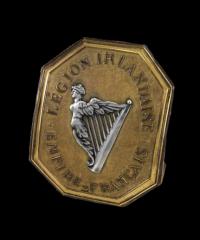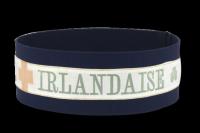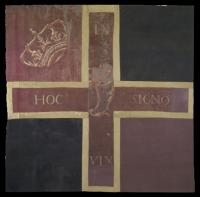Les Irlandais et la France: trois siècles de relations militaires
Published in 18th–19th - Century History, Artefacts, Early Modern History (1500–1700), General, Issue 1(Jan/Feb 2013), Volume 21
The Napoleonic Irish Legion cross-belt plate believed to have been worn by Captain Patrick McCann.
‘The Wild Geese’ is the romantic term traditionally applied to the men who left Ireland to join the armies of European countries. Beginning in the sixteenth century, large numbers of Irishmen enlisted in the armies of Spain, France, Austria and Russia. Many soldiers hoped eventually to return to Ireland and throw off foreign rule. This was never to happen, however, and their reality abroad was far from romantic. In the French army there were four periods when the Irish served in significant numbers: the Wild Geese regiments from 1688 to 1791, Napoleon’s Irish Legion from 1803 to 1815, the Franco-Irish ambulance unit in 1870 and the French Foreign Legion in the 1980s.
For most of the eighteenth century the French army included about half a dozen Irish regiments, named after commanders such as Walsh, Bulkeley, Clare, Lally and Dillon. The first recruits had left Ireland to follow the deposed King James II into exile in France, wearing their red uniforms, and thousands followed through the century until the French Revolution. There was only one Irish cavalry regiment in the French army, initially called Sheldon’s Regiment, and on display in the ‘Soldiers and Chiefs’ exhibition in the National Museum, Collins Barracks, is a sword of the regiment from 1700. Later the regiment was renamed Fitzjames’ and fought on 11 May 1745 along with 3,000 members of the Irish Brigade at the Battle of Fontenoy. The Brigade counter-attacked the British infantry, saving the day for the French. Also on display in the exhibition is the remains of the flag of the Dillon Regiment, which was carried during the battle, inscribed In hoc signo vinces (‘In this sign conquer’).

The 1870 Ambulance Irlandaise hatband worn by J.A. Smyth.
With the French Revolution, many of the Irish soldiers changed allegiance and joined the British army, but in 1803 the new French leader, Napoleon Bonaparte, created an Irish Legion. This unit fought in Spain and was composed of Irish officers commanding German and Polish enlisted men. On display in the exhibition is a gorget (the symbol of an officer, worn around the neck) and cross-belt plate believed to have belonged to Captain Patrick MacCann, an officer of the Irish Legion.
In October 1870, during the Franco-Prussian War, a large group of Irish medical volunteers served in France as part of a Franco-Irish ambulance unit until January 1871. On display are items belonging to J.A. Smyth, including a hatband of the Ambulance Irlandaise. Finally, during the 1980s, when the Irish Defence Forces were not recruiting and service in the British army was not popular owing to the Troubles, many Irish men joined the French Foreign Legion.
A sword of c. 1700 from the Sheldon Regiment, the only Irish cavalry regiment in the French army in the eighteenth century.
You can learn more about Irish soldiers in the French army in a new exhibition, ‘1689–2012, les Irlandais et la France: trois siècles de relations militaires’, which will be on display at the National Museum of Ireland, Collins Barracks, from January to June 2013, arranged by the French Embassy as part of the cultural events for Ireland’s EU presidency. HI
Lar Joye is curator of military history at the National Museum of Ireland (Decorative Arts and History).
Further reading
N. Genet-Rouffiac & D. Murphy, Franco-Irish military connections 1590–1945 (Dublin, 2009).

In hoc signo vinces (‘In this sign conquer’)—flag of the Dillon Regiment carried at the Battle of Fontenoy on 11 May 1745.
















